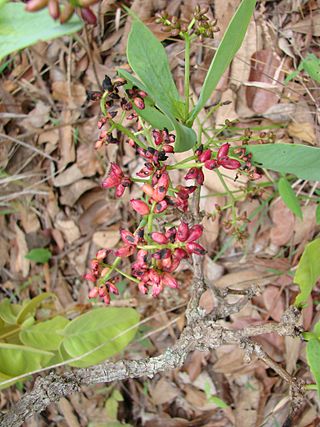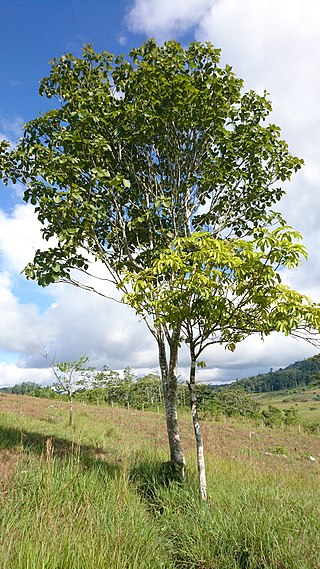
Manilkara is a genus of trees in the family Sapotaceae. They are widespread in tropical and semitropical locations, in Africa, Madagascar, Asia, Australia, and Latin America, as well as various islands in the Pacific and in the Caribbean. A close relative is the genus Pouteria.

Psychotria is a genus of flowering plants in the family Rubiaceae. It contains 1,582 species and is therefore one of the largest genera of flowering plants. The genus has a pantropical distribution and members of the genus are small understorey trees in tropical forests. Some species are endangered or facing extinction due to deforestation, especially species of central Africa and the Pacific.
Dussia is a genus of flowering plants in the family Fabaceae. It includes 11 species native to the tropical Americas, ranging from central Mexico to Bolivia and west-central Brazil.

Lennea is a genus of legume in the family Fabaceae. It contains three species native to central and southern Mexico and Central America.

Ladenbergia is a genus of plant in the family Rubiaceae.

Neea is a genus of plants in family Nyctaginaceae from the Caribbean region, Central and South America. Members of the genus are commonly called Nia, Neea, or saltwood.

Rustia is a genus of flowering plants in the family Rubiaceae. There are 17 species distributed in tropical Central and South America. They are shrubs and trees up to 15 metres (49 ft) tall.

Simira is a genus of plants in the family Rubiaceae. The genus was first published by French pharmacist and botanist Jean Baptiste Christophore Fusée Aublet in Hist. Pl. Guiane vol.1 on page 170 in 1775.

Paul Carpenter Standley was an American botanist known for his work on neotropical plants.
Conrad Vernon Morton was an American botanist, who did notable writings on ferns. He was also a specialist in Gesneriaceae and Solanaceae for the Smithsonian Institution from 1928.

Conzattia is a genus of flowering plants in the legume family, Fabaceae. It belongs to the subfamily Caesalpinioideae.

Voyria, commonly known as ghostplants, is a genus of 20 species of herbaceous perennial plants, belonging to the family Gentianaceae. They are mostly native to warm temperate and tropical regions of the Caribbean, Central America and South America, except for V. primuloides, which is found in West and Central Africa. V. parasitica reaches as far north as the Everglades in Florida.
Sidney Fay Blake (1892–1959) was an American botanist and plant taxonomist, "recognized as one of the world's experts on botanical nomenclature."

Pentagonia is a genus of over 40 species of plants in the Coffee or Gardenia family (Rubiaceae}. Pentagonia species are native to Central America and northern South America, and grow in moist tropical forests below 900m. The genus was first described by George Bentham in 1845. The genus is noteworthy for its opposite pairs of huge leaves in a variety of shapes including entire, shallowly or deeply lobed, and even pinnate. These leaves can, in the case of a recently discovered species be up to four feet long not including the six inch petiole, and up to 2.5 feet in width.

Carapichea is a genus of flowering plants in the family Rubiaceae. It is native to Central America and northern South America from Nicaragua to Brazil. One species, Carapichea ipecacuanha, is used medicinally as the source of ipecac, a powerful emetic.

Coussapoa is a genus of flowering plants belonging to the family Urticaceae.
Cuscatlania is a genus of flowering plants belonging to the family Nyctaginaceae.

Malanea is a genus of flowering plants belonging to the family Rubiaceae.
Schoenobiblus is a genus of flowering plants belonging to the family Thymelaeaceae.
Machaonia erythrocarpa is a species of flowering plant in the family Rubiaceae, native from Mexico through Central America to Panama. It was first described by Paul Carpenter Standley in 1940 as Allenanthus erythrocarpus. Allenanthus hondurensis is a synonym of one of its subspecies.













